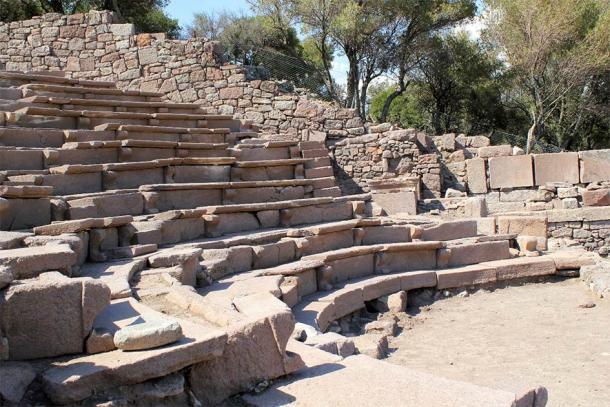Archaeologists working in a site have uncovered carved objects that are made out of goat bones . These carved goat bone objects were turned into ornaments in an ancient Greek colony over 2500 years ago. The recently discovered goat bone objects may help us to understand the ancient people who lived in this area, and how they survived in a hostile environment.
The unusual finds were made at the site of the ancient city of Aigai, where local archaeologists have been working for 16 seasons. Aigai is a city, now abandoned, that dates back to the 8 th century BC. This was the period when the Greek world was just coming out of an era of decline known as the “Dark Ages.” The site is in the northwestern Turkish province of Manisa, not far from the Aegean Sea , in a high altitude area called Nemrut Kale.

An ancient amphitheater at the ancient city site of Aigai where the goat bones objects were recently found. (Klaus-Peter Simon / CC BY-SA 3.0 )
Ancient Aigai Was One Of The Twelve Cities Of Aeolis
In ancient times, this region was known as Aeolis, after the migrants from Greece who settled the area around 1000 BC. Turcom.net reports that Aigai was ‘one of the twelve cities of Aeolis’ and was part of the Aeolian League before it was subdued by the Lydians and later became part of the Persian Achaemenid Empire . The town was not a major urban site as “owing to its unfavorable position in a remote spot in steep mountainous country,” reports Tucom.net. Aigai reached the zenith of its power under the Attalid dynasty of Pergamum, but fell into decline after a 17 AD earthquake before recovering again. It was finally abandoned in the early medieval period.
Archaeologists found the carved goat bone objects in a cistern, which had been used as a garbage dump around 2,500 years ago. The objects were removed from the site and examined by experts from the Middle East Technical University (ODTÜ) and Istanbul University. They established that the bones had been altered and processed. The experts believe, based on a thorough examination, that the bones were shaped and carved using domestic implements such as forks and knives and even hairpins.
Aigai Means Goat In Ancient Greek, And They Were Important
One object that is particularly striking depicts two fish. Yusuf Sezgin, the head of the dig, observed that word “Aigai” means goat in ancient Greek and that the city was famous for its goats in the past. Unsurprisingly, archaeologists have found many animals bones, especially from goats. The city was in a mountainous area with a harsh environment and was dependent on goats for food and leather.
Sezgin is quoted by Hurriyet Daily News that “that the meat, milk, and skin of the goat, which is the source of wealth of Aigai.” Moreover, based on the discoveries in the old cistern, the people of Aigai also used the bones of the goats. Every part of the animal was used for some practical purpose.

The ancient facade of the Aigai market hall seen from the interior. (Klaus-Peter Simon / CC BY-SA 3.0 )
Goat Bone Objects And Goat DNA Will Provide More Information
The bones are expected to yield some DNA and they could provide more insights into the ancient Greeks who once called this area home. Sezgin told Hurriyet Daily News that “We are working on the DNA of these goat bones in a [Scientific and Technological Research Council of Turkey] TÜBİTAK project.” This may tell researchers a lot about ancient goat breeds, including how they were bred some 2,500 years ago. The Hurriyet Daily News quotes Sezgin as saying that investigators will “examine the DNA of the bones uncovered and compare it with today’s goat breeds.” This can tell experts a great deal about the relationship between modern and ancient goats and can help them to understand the animals which were so important to the people of Aigai and other Greek communities.
The discovery of the unique goat bones objects is only the latest Aigai site find. Previously, experts found a spectacular bath mosaic that depicted Poseidon, the Greek god of the sea, and many important inscriptions on ruins at the site. There are many spectacular remains at this site on the city’s acropolis. And, nearby, stand the remnants of a once-famous sanctuary dedicated to Apollo, which is currently open to members of the public and tourists.
Top image: One of the carved goat bone objects, depicting two fish, face to face, recently found in an ancient Greek garbage dump in western Turkey. Source: Hurriyet Daily News
By Ed Whelan
Related posts:
Views: 1
 RSS Feed
RSS Feed

















 September 15th, 2020
September 15th, 2020  Awake Goy
Awake Goy  Posted in
Posted in  Tags:
Tags: 
















